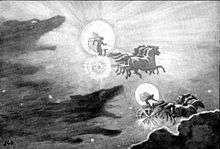Muspelheim
In Norse cosmology, Muspelheim (Old Norse: Múspellsheimr), also called Muspell (Old Norse: Múspell), is a realm of fire.
The etymology of "Muspelheim" is uncertain, but may come from Mund-spilli, "world-destroyers", "wreck of the world".[1][2]
Narrative
According to Norse myth there is said to be nine worlds. The Poetic Edda section Völuspá tells of them:
Nine worlds: the worlds of the gods (Asgard), of the Vanir (Vanaheim), of the elves (Alfheim), of men (Mithgard), of the giants (Jotunheim), of fire (Muspellsheim), of the dark elves (Svartalfaheim), of the dead (Niflheim), and presumably of the dwarfs (perhaps Nithavellir, cf. stanza 37 and note, but the ninth world is uncertain). The tree: the world-ash Yggdrasil, symbolizing the universe.[3]
Muspelheim is described as a hot and glowing land of fire, home to the fire giants, and guarded by Surtr, with his flaming sword. It is featured in both the creation and destruction stories of Norse myth. According to the Prose Edda, A great time before the earth was made, Niflheim existed. Inside Niflheim was a well called Hvergelmer, from this well flowed numerous streams known as the Elivog. Their names were Svol, Gunnthro, Form, Finbul, Thul, Slid and Hrid, Sylg and Ylg, Vid, Leipt and Gjoll.[4] After a time these streams had traveled far from their source at Niflheim. So far that the venom that flowed within them hardened and turned to ice. When this ice eventually settled, rain rose up from it, and froze into rime. This ice then began to layer itself over the primordial void, Ginungagap. This made the northern portion of Ginungagap thick with ice, and storms begin to form within. However, in the southern region of Ginungagap glowing sparks were flying out of Muspelheim. When the heat and sparks from Muspelheim met the ice, it began to melt. These sparks would go on to create the Sun, Moon, and stars[5], and the drops would form the primeval being Ymir. "by the might of him who sent the heat, the drops quickened into life and took the likeness of a man, who got the name Ymer. But the Frost giants call him Aurgelmer"[4]
The Prose Edda section Gylfaginning foretells that the sons of Muspell will break the Bifröst bridge as part of the events of Ragnarök:
|
See also
| Wikisource has original text related to this article: |
Notes
- Tilton, Theodore (1897). The complete poetical works of Theodore Tilton in one volume: with a preface on ballad-making and an appendix on old Norse myths & fables. London: T. Fisher Unwin. p. 705. Retrieved 2013-01-05.
- Vigfússon, Guðbrandur; Frederick York Powell (1883). Corpus poeticum boreale: Court poetry, vol. II. Oxford: Clarendon Press. p. 471. Retrieved 2013-01-05.
- Bellows, Henry Adams (1936). The Poetic Edda. New York: Princeton University Press. p. 3. Archived from the original on 2019-07-10. Retrieved 10 July 2019.
- Anderson, R.B (1879). The Prose Edda. Madison Wisconsin: University of Wisconsin. pp. 16–21.
- Encyclopedia of World Religions. Encyclopedia Britannica, inc. 2006. p. 803. ISBN 9781593392666.
